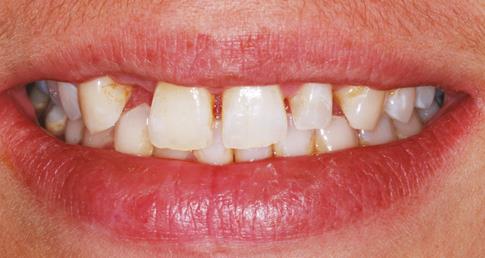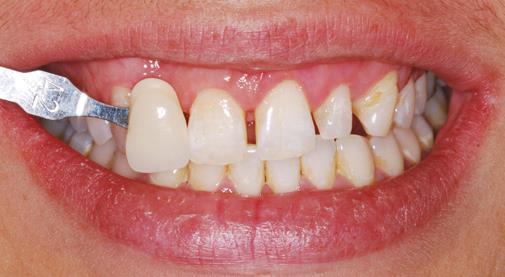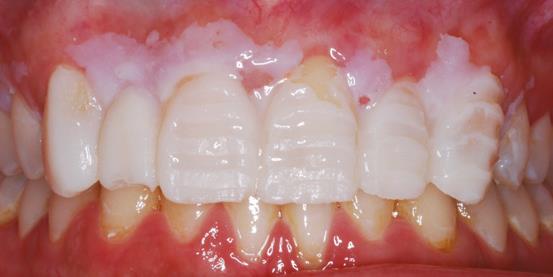Dental fixed restoration refers to the use of dental materials to replace or restore a missing or damaged tooth structure permanently. Fixed restorations are different from removable restorations like dentures, which can be taken out of the mouth for cleaning or maintenance.
Examples of dental fixed restorations include dental crowns, dental bridges, inlays, and onlays. These restorations are designed to match the shape, size, and color of your natural teeth, restoring your smile’s aesthetics and functionality.
Crowns are tooth-shaped caps that cover a damaged or decayed tooth, restoring its shape, size, and strength. Dental bridges replace missing teeth by attaching an artificial tooth to neighboring natural teeth, while inlays and onlays fill cavities or damage in the tooth’s biting surface.
Fixed restorations can be made from a variety of materials, including porcelain, ceramic, metal, or a combination of these materials.
PFM – Porcelain Fused to Metal
Porcelain fused to metal (PFM) is a type of dental restoration that combines the strength of metal with the aesthetic properties of porcelain. PFM restorations are commonly used for dental crowns and bridges.
The process of creating a PFM restoration typically involves creating a metal substructure that is designed to fit over the prepared tooth or teeth. The metal substructure is then coated with a layer of porcelain, which is fused to the metal in a high-temperature furnace.
The metal substructure provides the strength and durability of the restoration, while the porcelain layer provides the natural-looking appearance of the tooth. The porcelain layer can be customized to match the color and shape of the surrounding natural teeth, resulting in a restoration that blends seamlessly with the rest of your smile.
PFM restorations are generally considered to be a reliable and long-lasting option for dental restorations, and they can be used to restore teeth that have been damaged by decay, trauma, or other dental problems. However, some patients may be sensitive to the metal substructure, and the porcelain layer can wear down over time, requiring replacement or repair. Your dentist can help determine if a PFM restoration is the best option for your individual needs and recommend the appropriate treatment.
The standard in restorative dentistry. Anything is achievable with a PFM Crown. It has the flexibility of a metal occlusion to a 360-degree porcelain margin. Can be used with attachments for combination cases. Tooth colour can be reproduced three-dimensionally. Restorations can also be milled for a superior fit.


PFM and Full Gold
Despite the market trend of all-ceramic restorations, full gold and porcelain-fused-to-metal are still being used with tremendous success. These options have been used for over 50 years and have proven the test of time.


Precision Combination Attachment
The best treatment option is the one that works for your patient. When aesthetics are paramount and your patient requires partial and fixed restoratives, a combination of crowns, attachments and precision partials can provide the results you demand. A combination case can also be an alternative when implants are not an option. The process is initiated with a case analysis between the dentist and lab to design the optimum treatment strategy.


Pressed Ceramic Veneers
Leucite-Reinforced Glass Ceramic Veneers
Leucite-reinforced pressed glass ceramic veneers are ideal for various aesthetic complications (i.e. areas that require significant colour modification, pre-existing composites, fractured teeth, incisal wear). These veneers provide restorations that are biocompatible, with enhanced strength and improved aesthetics.
Vibrant Porcelain Veneers
Rotsaert’s own Vibrant Veneers are layered feldspathic porcelain which can be produced to a thinness of 0.3 mm. This makes them ideal for vital preparations, producing the most natural-looking veneers attainable. Bondable to enamel, Vibrant٠Veneers are a less invasive preparation. Vibrant٠Veneers…the choice of dental professionals for over 20 years, with more than 10,000 beaming smiles!


Vibrant™ Porcelain Veneers from 1.5 to 2.5 with a LAVA™ cantilever bridge 2.3-2.2
The clinician chose Vibrant™ Porcelain Veneers because of their beautiful translucency. These veneers are fabricated by layering porcelain on a refractory die enabling a three-dimensional build-up. For the bridge, a LAVA™ zirconia substructure was used for its high stability, precise fit, and excellent aesthetics matching the veneers.

Missing lateral and spaces between the teeth.

The patient wants a beautiful smile.

The tab is on the same plane as the teeth, as close to parallel as possible.

Preparation through acrylic stent designed from initial diagnostic wax-up.

Final Prep. Note the slight colour difference of the prepared teeth. This will be adjusted during veneer fabrication.



Final case with LAVA ™ cantilever bridge and matching veneers.
